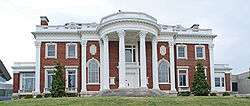Abram Garfield
Abram Garfield (November 21, 1872 – October 16, 1958) was the youngest son of President James A. Garfield and Lucretia Rudolph Garfield, and an architect who practiced in Cleveland, Ohio.
Abram Garfield | |
|---|---|
| Born | November 21, 1872 |
| Died | October 16, 1958 (aged 85) |
| Alma mater | Williams College, Massachusetts Institute of Technology |
| Occupation | Architect |
| Practice | Meade & Garfield |

Garfield received a bachelor of arts from Williams College in 1893 and a bachelor of science in architecture from the Massachusetts Institute of Technology three years later. By 1898, Garfield had joined with Frank Meade to form the architectural firm Meade & Garfield in Cleveland, Ohio; the firm was noted for its residential designs. When the partnership ended in 1905, Garfield opened his own firm until 1926 when he along with Rudolph Stanley-Brown, George R. Harris, and Alexander Robinson started an architectural practice. In 1935 it was renamed Garfield, Harris, Robinson and Schafer until Garfield’s death in 1958. The firm, which still exists, is now known as Westlake, Reed, Leskosky Architects. Garfield specialized in residential architecture, designing large houses in Shaker Heights and other Cleveland suburbs, but his work also included more modest houses for the Cleveland Metropolitan Housing Authority and institutional projects such as schools and a hospital. Garfield served as chairman of the Cleveland Planning Commission from 1930 to 1942 and was a founder and first president of the Cleveland School of Architecture, which became part of Western Reserve University in 1941.[1] He was named a trustee of the university that year and two years later was made an honorary lifetime member of the board; he received an honorary doctorate from Western Reserve University in 1945. Garfield was also a director of the American Institute of Architects from 1919 to 1922 and served on the U.S. Commission of Fine Arts from 1925 to 1930, including as vice chairman from 1929 to 1930.[2] In 1949 he was elected into the National Academy of Design as an Associate Academician. He lived in Bratenahl, Ohio.[3]
A number of his works are listed on the National Register of Historic Places.[4]
Works
.jpg)
Garfield's works include:
- Casa Apava, an estate built in 1918 for Chester C. Bolton and Frances P. Bolton on Ocean Boulevard in Palm Beach, Florida.[5][6] After Ron Perelman sold this house and two adjoining properties to Dwight Schar in 2004 for a reported $70 million ($45 million for the house),[7] Forbes magazine described this as "the most expensive home ever sold in the U.S."[8] It was sold for $71.2 million in 2015.[9]
- Elizabeth B. and Dudley S. Blossom Estate Service Compound, 24449 Cedar Rd. Lyndhurst, Ohio (Garfield, Abram), NRHP-listed[4]
- Faxon-Thomas Mansion, now the Hunter Museum of American Art, 10 Bluff View Ave. Chattanooga, Tennessee (Garfield, Abram), NRHP-listed[4]
- Garfield Library, 7300 Center St. Mentor, Ohio (Garfield, Abram), NRHP-listed[4]
- The Hangar, 24400 Cedar Rd. Beachwood, Ohio (Garfield, Abram), NRHP-listed[4]
- Hay-McKinney and Bingham-Hanna House, now the Western Reserve Historical Society, 10825 East Blvd. Cleveland, Ohio (Garfield, Abram), NRHP-listed[4]
- John G. Oliver House, 7645 Little Mountain Rd. Mentor, Ohio (Garfield, Abram), NRHP-listed[4]
- Leonard Hall, a dormitory at Kenyon College.[10] Built in 1924.
- Mather House at Case Western Reserve University, built 1913-1915
- Pebble Hill Plantation, US 319, 4 miles (6.4 km) southwest of Thomasville Thomasville, Georgia (Garfield, Abram), NRHP-listed[4]
References
- "Abram Garfield". Encyclopedia of Cleveland History. July 16, 1997. Retrieved August 16, 2012.
- Thomas E. Luebke, ed., Civic Art: A Centennial History of the U.S. Commission of Fine Arts (Washington, D.C.: U.S. Commission of Fine Arts, 2013): Appendix B, p. 544.
- Abram Garfield - Cleveland City Planning Commission Retrieved 2018-05-19.
- "National Register Information System". National Register of Historic Places. National Park Service. July 9, 2010.
- Frederic M. Winship, "Sky's the limit (except for price) in luxury homes", Chicago Sun-Times, April 24, 1987 – via HighBeam Research (subscription required) .
- Chester C. Bolton House (Casa Apava), Historic American Buildings Survey, Heritage Conservation and Recreation Service, Summer 1971.
- Sandra Fleischman, "18 Baths, Beach for a Cool $70 Million", The Washington Post, January 29, 2005 – via HighBeam Research (subscription required) .
- Isabella Geist, "Ron's $70 Million Sale", Forbes, November 5, 2004.
- Palm Beach Daily News.com: "Casa Apava sells for $71.2 million", April 1, 2015.
- "Kenyon College Virtual Tour". www.kenyon.edu. Retrieved 2018-03-13.
External links
| Wikimedia Commons has media related to Abram Garfield. |
- Howard Babcock, "Garfield's Son Recalls Tragedy", Central Press Association in Kentucky New Era, August 8, 1957, p. 18.